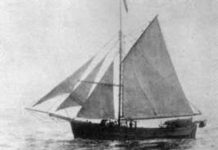
Nursing Sister Georgina Fane Pope earned Canada’s first Royal Red Cross Medal for her dedicated nursing service in the Boer War in South Africa
The Pope household in Charlottetown, Prince Edward Island was a hotbed of journalism, legal issues and political strategies in the late 1800s. Well-heeled and comfortable, William H. Pope and his wife welcomed their newborn daughter on January 1, 1862, naming her Cecily Jane Georgina Fane Pope. A determined politician, William rose in the political arena to become one of Canada’s honoured Fathers of Confederation.
Raised in affluence, Georgina was a young woman with grace, education and options. Rather than finding a good man to marry and running a traditional home and family, she chose a different route. Attending nursing school at the prestigious Bellevue Hospital School of Nursing, opened by Florence Nightingale, the pretty graduate practiced her new skills as a nursing sister in New York City. (Nursing care was in its infancy in the 1800s, and nurses were not yet considered professionals.) In October 1898, Georgina returned to Charlottetown and immediately signed on as a volunteer to join the troops for service in the Boer War.
Georgina Fane Pope in South Africa’s Boer War
The Boer War was a bloody, gruesome war in South Africa between the Dutch settlers and the British Imperial Forces. A battalion of Canadian volunteers was sent in aid of the British. It was the first war in which Canada officially sent troops, though it was against Prime Minister William Laurier’s judgment. (The Dutch word “Boer” means “farmer.”) Georgina was chosen as head of the small nursing team of four women attached to the troops. The nursing sisters were given the rank and pay of Lieutenant.
Battlefield Nursing in Boer War
Initially caring for sick and wounded soldiers in British hospitals near Cape Town, Georgina and the nursing sisters moved north to field hospitals in Kroonstadt. Four more nurses joined later. “These hospitals were often not more than a hut or tent that could move along with the army,” said Library and Archives Canada’s Cool Canada entry titled “Georgina Pope (1862-1938).” While there, “the nurses were on constant lookout for snakes and scorpions.” It was a difficult, miserable time, with insufficient food rations, long hours, shortages of medical supplies and extreme temperatures. Many of the ailing soldiers – about 230 men – suffered from enteric fever, also known as Typhoid Fever. Fear of enemy attack on the crowded hospitals was ever-present.
Royal Red Cross Medal Awarded to Pope
Georgina returned to Canada in January 1901, remaining in the Reserves. With Canadians still in the ravages of battle in South Africa, she was again sent to head a unit of nursing sisters in March 1902. Working at a hospital in Natal, the tour of duty was short, as the Boer War ended three months later. Back in Prince Edward Island, Georgina was commended for her dedicated service with the Royal Red Cross Medal in 1903. The British and Commonwealth medal to honour exceptional military nursing service was established by Queen Victoria in 1883. Georgina was the first Canadian to receive the significant award.
Georgina Pope the First Matron-in-Chief of CANC
Working at the Garrison Hospital in Halifax in 1906, Georgina became a regular member of the Canadian Army Medical Corps. In 1908, Georgina was appointed Nursing Matron-in-Chief of the Canadian Army Nursing Corps, “which made her responsible for the permanent nursing sisters as well as the reserve nursing service,” noted Parks Canada’s This week in History Archives in “Patients and Devotion: Georgina Fane Pope.” She was the first permanent member of the CANC. (Established in 1901, the Canadian Armed Forces nursing corps was made part of the military reserves in 1904, initially enrolling 25 nursing sisters.) Georgina’s duties fell mainly in the areas of nursing recruitment and hospital administration. A visible mark of Georgina’s presence was her decision to change the nursing sisters’ uniforms from khaki colour to navy blue. She also added an insignia in the shape of a maple leaf with a crown placed over the word Canada.
For a period of several years, Georgina suffered poor health. Recovered somewhat by September 1917, she accepted a tour of nursing duties overseas during WWI at age 55. Working in Canadian military hospitals in England, she was also stationed in France near the appalling, fierce battles of Ypres, according to Cool Canada. Succumbing to another bout of illness – which may have included shell-shock – she was sent home to Canada in August 1918. Retiring, Georgina lived in her hometown of Charlottetown, Prince Edward Island until she died on June 6, 1938. She was 76 years old.
Matron-in-Chief Georgina Fane Pope was buried three days later in the Charlottetown Roman Catholic Cemetery with full military honours. It seems that she did not marry or have any children. Devoting her heart and soul to her career, Georgina was a pioneer in the specialty of Canadian military nursing.






